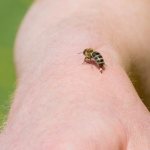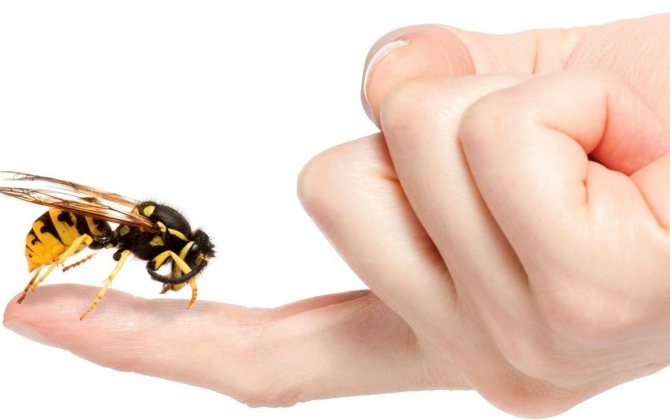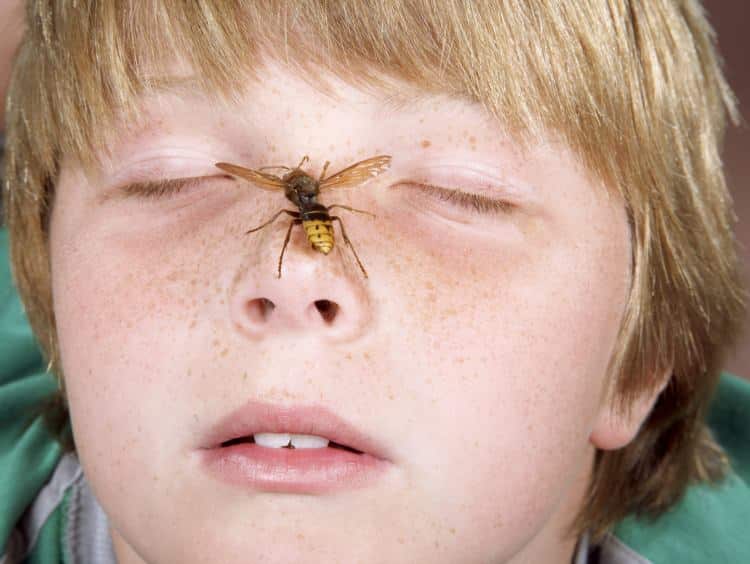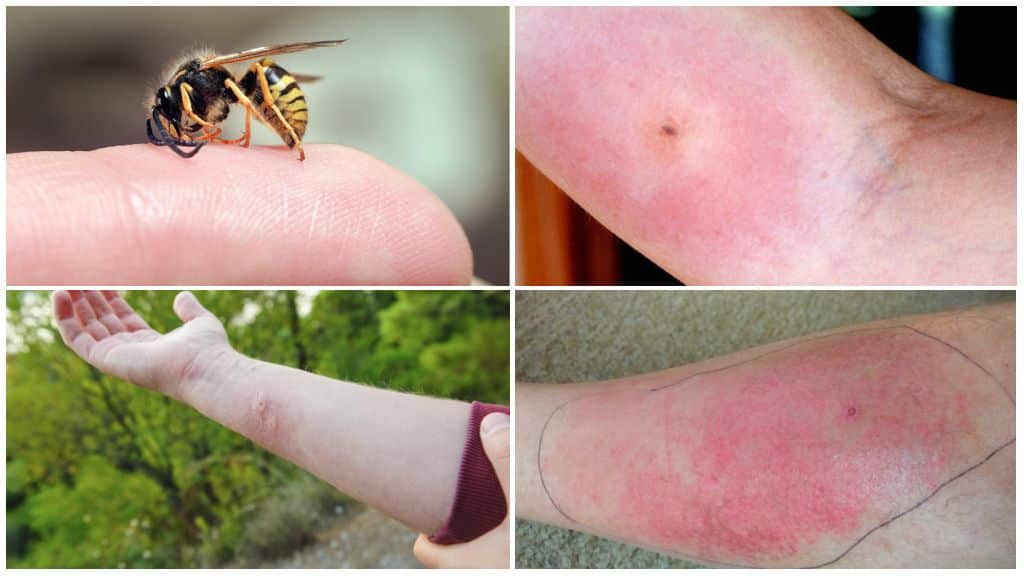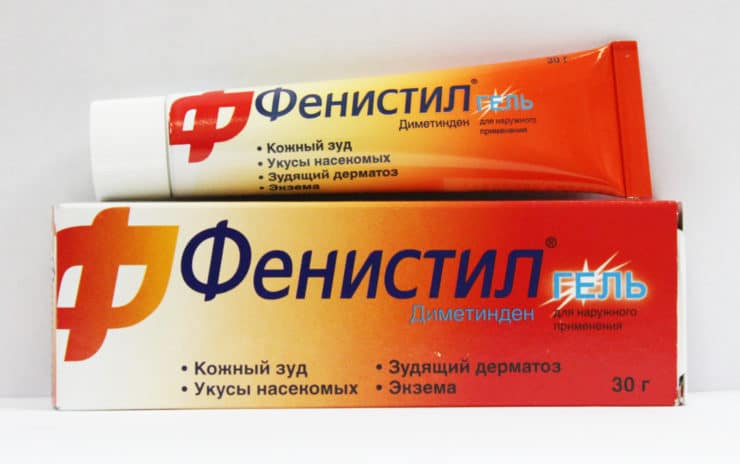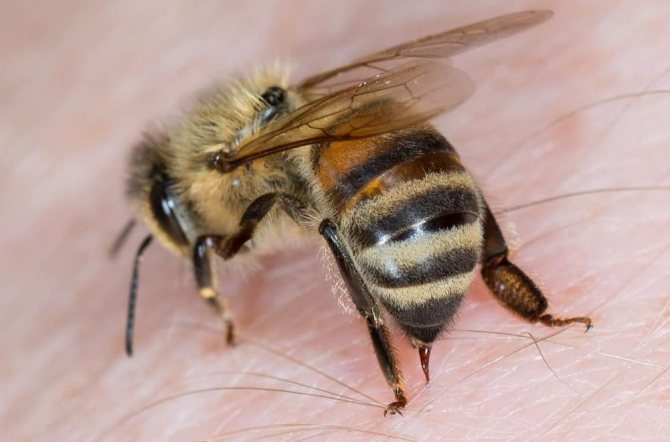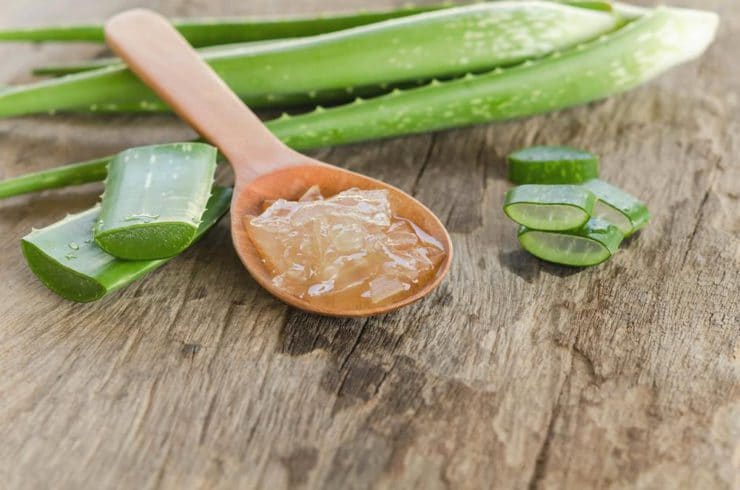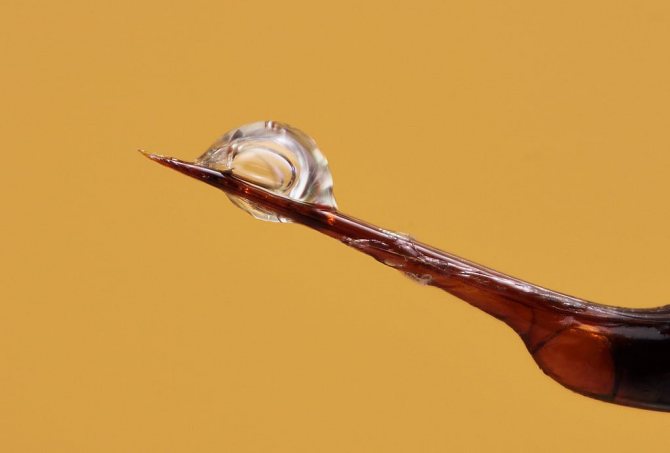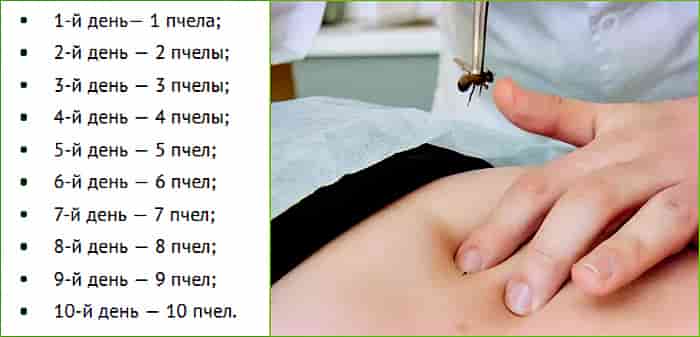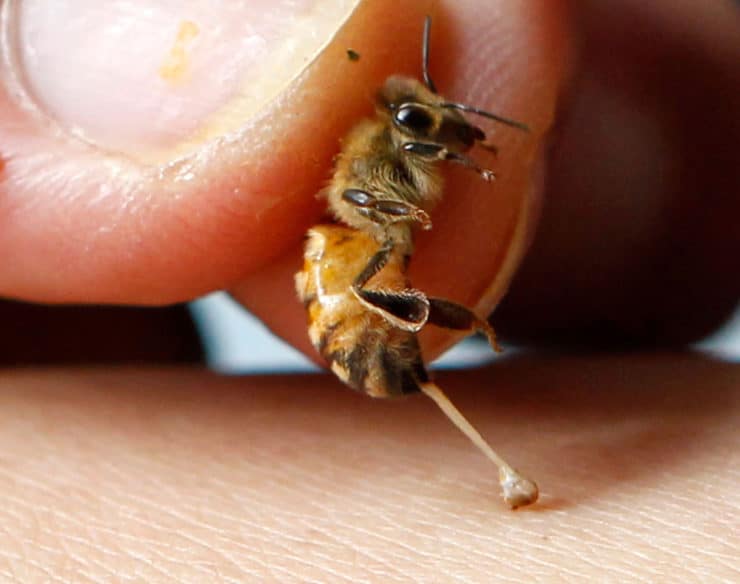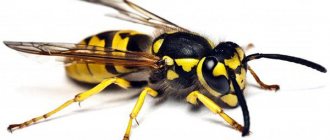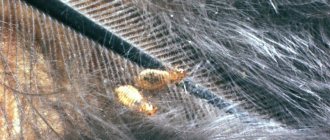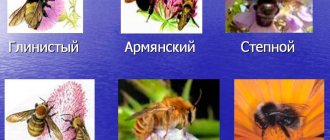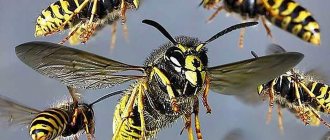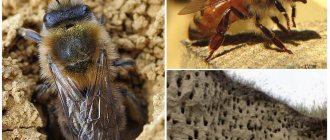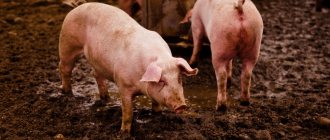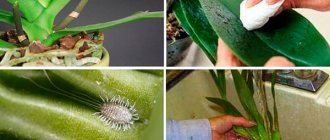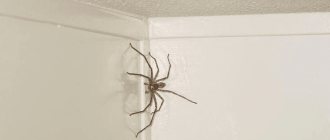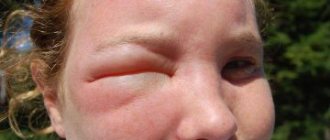A bee sting is an unpleasant but common occurrence. No one is immune from the attack of these insects - neither adults nor children. Bee venom is not at all as harmless to humans as it seems. In an unfortunate combination of circumstances, it can cause the death of the victim. To prevent this, one must be able to provide first aid to the stung and take measures to prevent the negative consequences of the penetration of bee venom into his body.
The consequences of a bee sting
After a person has been bitten by a bee, edema appears. With proper first aid and further treatment at home, it lasts about 1-5 days. It all depends on the victim's body. In children, edema persists for a longer period. Other manifestations of the body's normal reaction to a bee sting:
- hives;
- burning, pinching, itching in the affected area;
- rash and redness around the bite.
If the swelling does not subside for 7 or more days, then you need to see a doctor. The same applies to a severe allergic reaction, which is manifested by the following symptoms:
- tremor of the limbs;
- body aches;
- lacrimation;
- cough;
- shortness of breath;
- shortness of breath;
- bronchospasm;
- increased heart rate;
- increased sweating;
- nausea, vomiting;
- headache;
- dizziness.

The dog who decided to taste the bee.
Here are the consequences of the bites of these insects:
- Cell destruction, causing redness and inflammation.
- The poison contains a special toxin that has a strong effect on the central nervous system.
- A high concentration of histamine substances that contribute to the development of puffiness, redness and subsequent allergic reactions. Some people do not tolerate bee venom, and their body reacts to it with severe swelling when a bee stings.
- Dissolving in the blood, the poison provokes the breakdown of red blood cells.
- The individual reaction of the body: shortness of breath, weakness, severe or tolerable pain.
- Edema forms at the site of the bite, its size and duration of treatment depend on the tolerance of the poison by the human body.
- You may notice that the wound is swollen, and the redness around it is rapidly increasing.
- In rare cases, there is a rapid heartbeat and deep fainting.
Young children and adolescents most often suffer from allergies, and in these cases, you should immediately consult a doctor. If this is not possible, then it is better to give the child an approved anti-allergy drug, and apply anesthetic ointment to the damaged area.
After extraction, the wound is washed with potassium permanganate or rubbed with alcohol, carefully treated with iodine. All procedures are carried out very carefully. The most painful is a bee sting in the eye, palate, tongue, cheek, head, neck.
After removing the sting, the wound is washed with potassium permanganate or rubbed with alcohol, carefully treated with iodine
You can cure the bite site and relieve the swelling with the following medications:
- Place a cotton swab or a piece of gauze with a small amount of "Psilo-balm" or "Elok" on the bite site. You can also use Hydrocortisone, Soventol, or Fenistil-gel ointment.
- To relieve puffiness, a wet bandage or ice, previously wrapped in a bag, is applied to the damaged area.
- For the prevention of allergies, it is recommended to drink antihistamines within 1-3 days: Ephedrine, Suprastin, Diphenhydramine, Pipolfen. It is recommended to drink an antihistamine for a bee sting until the edema completely subsides.
- To anesthetize the wound will help a tablet "Validol" soaked in water, cotton wool soaked in "Menovazin" or a solution of calendula.
You can not give the victim a hot drink: under the influence of hot bee venom is absorbed into the blood faster. But cool and even cold water can be in large quantities, so that the body is quickly cleansed.
Many people who are faced with such a problem often wonder whether the temperature can rise from a bee sting. The consequences after a bee sting are individual for each person, they can be expressed not only in the form of fever, but also weakness, as well as in the form of headache, nausea, vomiting and diarrhea.
What to do if you don't have the right medicines at hand: folk remedies
If there is no medicine at hand, then the wound can be treated with vodka or other strong alcohol. And this is missing? Then wipe the wound with chopped parsley, plantain, apply aloe vera juice or garlic, these are proven folk remedies for a bite. They will help relieve puffiness, pain and temporarily disinfect the wound.
The following bee sting remedies will help to draw out the poison and relieve swelling:
- A lump of sugar, previously soaked in water and applied to the wound.
- An allergic reaction in a mild form will help to remove a decoction of parsley (2 tablespoons of parsley root, pour 500 ml of boiling water).
- Attach a cut apple or potato to the wound.
How to avoid bee stings
How to avoid being bitten by these insects? Attempts to ward off the insect with a towel or something similar will end badly. Calm behavior will not cause aggression, and you can protect yourself from a bee sting.
If you see insects near you, do not panic, stop waving your arms or chase them away
It is worth explaining to young children that insects cannot be caught and driven away. During the warmer months, your little one can eat ice cream or something sweet outside. Look after him, because it is not uncommon for a child to put a bee in his mouth along with a piece of goodies. Such examples are rather sad. When stung, the child is frightened, and bites on the tongue or palate are painful, they can cause severe allergies.
Also, you cannot kill an insect: even more of its relatives will flock to the smell of its poison. If an insect has flown into your open window, catch it with a towel and release it outside. Despite the potential danger, bees are very useful insects that provide people with delicious honey, and their venom is used to make medicines.
Note that bee stings are not as dangerous as, for example, hornet stings. When the latter is damaged, one can notice that the pressure has jumped, and the pulse has increased by 10–20 units.
No one is able to predict the moment at which a bee may sting, for this reason it is necessary to be able to provide first aid after a bee sting.
When visiting an apiary or drinking tea with honey on the street, you should not use cologne, perfume, or use fragrant gels when washing. When a bee appears nearby, you should not wave your hands or a towel at it, slap on the table or run into the house.
It is better to sit quietly, covering your hair with a scarf, a cap, or quietly leave the street to the room.
First of all, it is worthwhile to calm down the child, not letting him scream or run around the lawn, and calmly drive the dog into the kennel. Be sure to wash your hands and face after sweet treats and sticky fruits. Killing a bee is also not worth it - the smell of its poison, released when smeared with a newspaper or rag, will surely flock others. If it flew into an open window or window, it is better to catch it with a towel, then release it back.
In reasonable doses, apitoxin has a beneficial effect on the human body. But it is impossible to practice apitherapy without making sure that there is no allergy. Bee stings are safe only if the person is healthy and has no intolerance.
In order not to become a victim of an angry swarm, you should know that bees sting only in case of a threat. Do not wave your hands next to the bee's nest. Also, insects react negatively to the smells of alcohol, perfumery.
You can get rid of the bee nest on the site with the help of insecticides. But there is also a more humane way: put on personal protective equipment, fumigate the nest with a smoke, take the swarm together with the "house" into the forest. But such manipulations are within the power of a specialist, it is more important to remember what to do so as not to anger insects.
The benefits of bee sting. How does it help?
A substance called bee venom has certain benefits and is represented by a composition of a large number of elements:
- proteins;
- peptides;
- amines;
- lipids;
- amino acids;
- pheromones;
- carbohydrates;
- fats;
- mineral components.
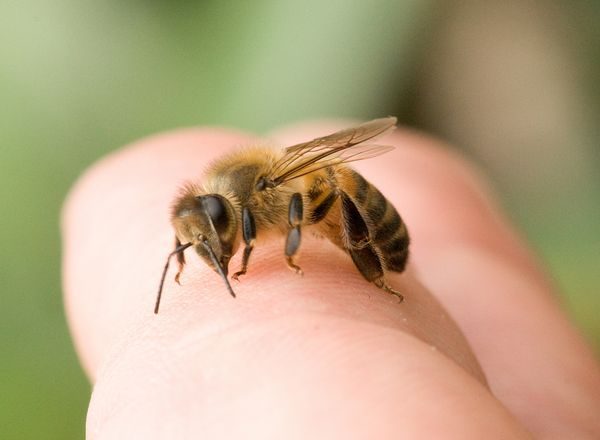

Bee treatment
The development of allergies is influenced by some proteins (hyaluronidase and phospholipase), amines (histamine), peptides (melitinn). At the same time, these components, along with others, have a favorable effect on the human body. Each of them has different properties.
Providing help or what to do with a bee sting


The doggie thought that bees were peaceful insects.
In folk medicine, it is believed that bee stings are good for health, there is a whole section of medicine - apitherapy, which is devoted to the treatment of various diseases with bee venom. However, a bee sting, in addition to being very painful, can cause an allergic reaction - which is why it is necessary to be able to provide first aid.
So, after a person has felt a sharp burning pain from a bee sting, the following must be done:
- Carefully examine the bite site, which looks like a raised red spot (papules) above the skin - a sting should be visible in the center. If it is not there, two options are possible - either the sting is inside the wound, or the victim was stung by a wasp;
- It is imperative to remove the sting. This can be done with tweezers or nails. If the sting is in the wound, it should be squeezed out of there, and you need to continue pressing until a drop of blood appears from the wound - this way you can remove most of the poison. You can use a regular sewing needle to remove the sting, however, before use, the needle must be calcined over a fire or treated with an antiseptic. The wound should also be disinfected;
- Treat the bite site with an antiseptic - any that is at hand will do;
- Apply cold to the bite. Any cold object will do, but it is important that it is clean, otherwise there is a risk of infection;
- Apply for 15-20 minutes to the wound a piece of bandage or cotton wool soaked in soda solution (1 teaspoon of soda in a glass of water), a compress with soda gruel (add a few drops of water to a teaspoon of soda and stir until mushy);
- The bitten site can be treated with a local antihistamine (antiallergic) agent, for example Fenistil in the form of a gel or Psilo-balm;
- Take an antihistamine orally. This first aid measure is necessary if there is a too violent reaction of the body (the appearance of general symptoms, suffocation, skin rash, edema, enlargement of papules, etc.), if the victim is prone to allergies (without waiting for its symptoms), and in children under 12 years of age.
It is also recommended to give the victim plenty of drink - water, sweet tea, compote, etc. in order to reduce the concentration of the poison in the body and accelerate its excretion.
As a rule, these actions are enough to relieve pain and prevent possible unpleasant consequences of a bite.
The little worker bee has an individual defense mechanism.It includes a stinging "needle" and associated poisonous glands. In a calm state, the tip is hidden in her body. In case of danger, it pierces the enemy.
If the rival is another insect, then such a “duel will not be fatal for the honey miner. During interaction with animals and humans, its small notches are pierced into the victim. The bee breaks out, leaving part of the glands at the opposite end of the "tool", dying at the same time.
Removing the sting from the skin
The longer the “poisonous instrument of defense” is under the skin, the deeper it penetrates, the more the amount of poison that has entered the bloodstream increases. Trouble is also increased by the risk of inflammation of the bite site, due to the presence of a foreign body in the skin.
The sting has acquired a well-known appearance and functionality over the course of evolution. In its place, the "prehistoric" bees had a tube through which they laid eggs.
2% of people have an allergic reaction to bee stings. This means that under certain conditions, the ingress of bee venom into their body can cause a severe reaction, up to and including death. In this case, first aid measures are not enough and emergency medical care is indispensable. Also, bites in some particularly vulnerable areas of the body are at increased risk.
Urgent medical attention is needed in the following situations:
- Multiple bites. In this case, a high dose of bee venom can lead to the most serious consequences, up to respiratory arrest;
- Bites in the neck, mouth, eyes. In the first two cases, suffocation is possible due to edema of the tissues of the upper respiratory tract, bee stings in the area of the eyes can cause severe inflammation;
- The presence of an allergic reaction to the bite. The following symptoms should be alerted: the appearance of shortness of breath, perspiration and / or cramps in the throat, a feeling of tightness in the chest, as well as massive swelling, rash, nausea, vomiting, difficulty breathing, loss of consciousness.
In all these cases, an ambulance should be called, or the victim should be taken to the hospital as soon as possible. You also need to see a doctor if the pain, swelling and redness at the site of the bite do not decrease within three days.
Pain at the injection site, itching, redness and swelling are considered normal reactions. After a few hours, the soreness (along with swelling) subsides.
It is widely believed that bee venom is easily neutralized by ingested alcohol, so you can often find advice to drink 30-50 g of vodka or brandy if you are stung by a bee. For obvious reasons, this "treatment" is not suitable for children, however, adults should not do this either. The fact is that alcohol does not remove or neutralize toxins, but, on the contrary, facilitates their penetration into the body and complicates their excretion.
Also, when providing first aid, you do not need to do the following:
- Rub the bite site and press on it (the exception is squeezing the poison out of the wound, i.e. pressing in a special way);
- Apply earth, clay to the wound, wash and cool it with river, lake water or water from puddles. This is likely to lead to infection, up to tetanus;
- Kill the bee. Firstly, a bee that is left without a sting dies on its own. Secondly, if you crush it, special volatile substances are released, notifying the bees in the vicinity of the danger. This can attract many other bees to you, angry and ready to attack.
If the bee does get bitten, follow these guidelines to help avoid complications and reduce pain.
- First, remove the sting from under your skin.
- Treat the wound with an antiseptic.
- Refrigerate the bite site.
Usually, the bee plunges its sting under the victim's skin for its entire length.In this case, a person experiences the same symptoms as when a foreign body gets under the skin, like a very thin and sharp needle. The more time passes from the moment of the bite, the more bee venom enters the body. In addition, the likelihood of suppuration of tissues in the vicinity of a foreign body increases.


First aid for a bee sting is to remove the sting as quickly as possible. Insect venom is located inside special reservoirs in the sting, and continues to penetrate into human tissues as it deepens into the body over time. By pulling out the sting immediately after the incident, you can reduce the amount of bee venom that will enter the body, and thus reduce the accompanying unpleasant symptoms.
Removing the tip:
- The sting is easiest to remove with tweezers, which it is advisable to pre-disinfect.
- If there are no tweezers in the vicinity, you can remove the sting without any tools, simply knocking it off with your fingernail, but it is advisable to first wipe your hands with alcohol.
- At home, you can use a disinfected knife to remove the sting.
These manipulations will help to avoid or reduce inflammation near the bite site. After removing the sting, you need to rinse and disinfect the wound.
The easiest way to reduce the pain, itching, and swelling that accompany a bee sting is to wash the wound with laundry soap and apply an ice pack. You can also use compresses with vinegar, alcohol, soda solution and diluted potassium permanganate to disinfect and relieve inflammation.
Of the medicines, the following will help to remove the swelling after a bite: fenistil ointment, psilo balm, hydrocortisone ointment.
If you have to meet with the fact that the dog is still bitten by a bee, first of all you need to calm down yourself. After all, dogs sharply feel fear, and the panic on the part of the owner can do nothing to help her, but will only aggravate the situation. Next, you need to find the place of the bite itself, find the sting, which should be carefully removed with tweezers (scissors) and squeeze the poison out of the wound.
After, when the sting is successfully removed, it is worth treating the bite area. To do this, you can take cotton wool or a cotton pad, moisten it with ammonia and rinse the wound. You can use regular vodka or treat the affected area with iodine or potassium permanganate. If none of the above is at hand, rinse the bite site with water or resort to folk methods.
Such manipulations should be done immediately after the bite or as soon as possible. Be sure to give the dog a lot to drink and encourage the pet, because he is still going through stress.
Of course, it is recommended to lubricate the bite site with an anti-itch ointment (since the dog will certainly scratch the wound) and against an allergic reaction. You can also give your dog a shot to help with allergies, or give a pill.
The main goal of a bee sting is to relieve swelling and relieve pain. In general, often, such bites do not lead to anything serious. The main thing is to take the right measures right away. If there is uncertainty in your actions, it is better to ask for help or immediately contact your veterinarian so as not to harm your pet.
After all the actions taken, it is necessary to limit the pet's ability to move in order to reduce its pain, relieve swelling and not provoke blood flow to the area affected by the poison. The dog should be examined to make sure there are no other bites.
To reduce the harm from a bee sting, first aid should be given. If a person has an allergy, the victim should be urgently taken to a hospital. Sometimes anaphylactic shock after a bee sting develops within a few minutes, and the person can die. Situations when a bee sting occurred in the head are considered especially dangerous. In this case, you need to immediately start treatment measures:
- pull out the sting,
- lay the victim on a horizontal surface, raising his legs,
- treat the wound with a non-alcoholic antiseptic - potassium permanganate, hydrogen peroxide, chlorhexidine,
- turn your head to one side, make sure there is breathing, in the absence of it, breathe from mouth to mouth,
- in the absence of a pulse, an indirect heart massage is performed.
| Situation | How to provide first aid? |
| Child bitten by a wasp / bee in the finger | There is a fundamental difference between a bee and a wasp sting. A bee leaves a sting in the body, because its sting is serrated, and in a wasp the sting is smooth, it does not leave it in the body. If a bee stung, then first you need to disinfect the sting site with hydrogen peroxide, alcohol or a weak solution of potassium permanganate, then very carefully pull out the sting with tweezers or a needle so as not to crush the ampoule with poison located at the end of the sting. Then attach a swab dipped in a soda solution, because The pH of bee venom is acidic and is neutralized by an alkaline solution. If a wasp stung, do everything, the same, just don't poke around in your finger trying to find the sting. He's just not there. After disinfecting the bite site, attach a tampon soaked in table vinegar with 3% vinegar, because The pH of the wasp venom is alkaline. Keep the tampon in both cases for 15 minutes. |
| Child bitten by a wasp / bee in the hand | In the case of a bite on the hand, all first aid manipulations are performed in the same order as for a bite on the finger. |
| Child bitten by a wasp / bee in the face | If a wasp / bee stung a child in the face, then in this case, first aid will be similar to the two previous ones. Disinfect and remove the sting. Then attach a tampon dipped in a soda solution or a solution of potassium permanganate. Do not forget that a bite in the face can cause complications, because the skin in this part of the body is tender and the poison penetrates into small blood vessels faster. It is advisable to apply ice to avoid or delay the spread of the poison. If there are no hospitals nearby and medical care is not available, use proven folk recipes: treat the wound with garlic or plantain juice and attach a cut tomato, cucumber, onion or apple. Finely chopped parsley root helps a lot, it's good if thrifty housewives have a tincture of propolis or calendula. |
| Child bitten by a wasp / bee in the leg | With a bite in the leg, the first aid scheme does not fundamentally change. |
| Child bitten by a wasp / bee on the lip | In this case, it is necessary to stop the spread of swelling and inflammation as soon as possible. We quickly remove the sting, if there is one, apply ice or a handkerchief dipped in water. It is advisable to have ascorbic acid, loratidin or suprastin with you, if they are not available, you can give the victim a lot to drink non-hot sweet black tea. Already sounded folk methods will help here, but it is better not to postpone a visit to the doctor. |
| Child bitten by a wasp / bee in the neck | Since the site of the bite is located near the lymph nodes, first of all, you will have to take care of the non-proliferation of poison. All of the above actions will help neutralize the threat of edema. Give plenty of fluids to drink, preferably in small doses at short intervals. Pharmacological balms will protect the baby's skin from damage, antihistamine ointments will reduce irritation and increase the body's resistance. |
| Child bitten by a wasp / bee in the eye | The most difficult case. Try to see a doctor as soon as possible, if possible, give antiallergic drugs in an acceptable dosage. Explain to your child that crying in this case is very harmful, but do not frighten, but distract his attention from the pain. |
Helpful information
Bee venom in small doses is a medicine, in large quantities it causes intoxication. The threshold at which it causes poisoning is relatively high: in healthy men it is 700-1000 bites, in women it is slightly less, and in children - up to 90 bites.The exception is people with an allergy to apitoxin (about 1% of the population), whose tolerance is zero.
This fact must be borne in mind. First, so as not to underestimate bee venom, which in exceptional cases can have fatal consequences. Secondly, to prevent fear of him. Indeed, according to the latest scientific evidence, it is an excellent therapeutic agent.
How to reduce the chance of a bee sting
Bee stings are always painful. Try to stay calm after a bee attack. Most likely, nothing bad will happen to you. However, allergies can occur at any time in life, even if you have tolerated bee stings before
It's important to keep track of your symptoms.
If you plan on spending time outdoors, take steps to reduce the chances of a bee sting:
- Do not walk barefoot on the grass.
- Do not climb into hives.
- Do not use perfumes, shampoos, or other highly scented cosmetics.
- Do not wear brightly colored or floral clothing.
- Cover your food.
- Do not drive with the window open.
- Do not drink carbonated drinks from open glasses.
- Beware of open trash cans.
Contraindications
Treatment with bee stings has many contraindications. So, as the poison itself in large quantities provokes the poisoning of the body. Therefore, in order to avoid unpleasant consequences, before bee sting, you need to familiarize yourself with the contraindications and find out if you can be treated this way. Among them:
- a weakened body or immunity after outbreaks of chronic diseases;
- tuberculosis;
- malignant tumors;
- disrupted work of the pancreas and kidneys;
- diseases of the circulatory system;
- infections;
- Addison's disease;
- the period of pregnancy or lactation.


Handsome with a swollen nose
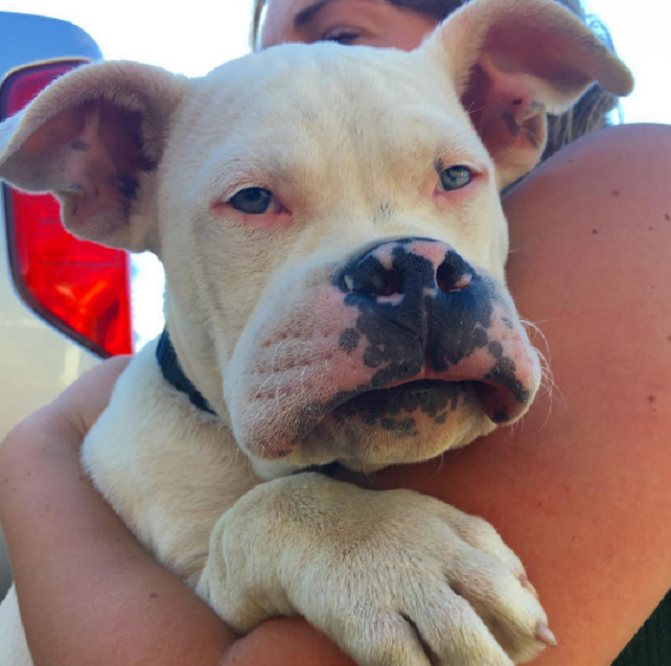

Acquaintance with the bee led to a swollen nose and a swollen muzzle.


This dog just wants this day to end as soon as possible.
When a bee bites
There are a few simple rules to help prevent a bee attack:
- if the insect has flown too close, do not drive it away with your hands. You need to stand still and not twitch until the bee flies away;
- try not to be afraid, since these insects, according to some scientists, feel when adrenaline is produced;
- do not wear bright clothes that can attract bees, who are accustomed to identifying flowers in this way;
- avoid odorous deodorants and perfumes that attract insects;
- do not walk barefoot on the grass.
To prevent an incident, you need to remain calm and not panic at the sight of a bee. After all, these insects never attack first.
The most important rule is under no circumstances to wave a rolled newspaper or fly swatter at a bee if it has flown into the room. You just need to open all the windows and wait for the insect to fly away.
Many people ask the question: why some people are bitten by bees, while others are not. Let's try to figure it out.
Bees are intelligent insects that have developed:
- Visual memory.
- Smell.
- Touch.
- Fast reaction.
- Protective and defensive functions.
They take care of the offspring and food, therefore, with a sharp movement, a loud cry, an attempt to escape, a person provokes an insect to attack.
Also, these insects do not tolerate strong smells of perfume, sweat, tobacco or alcohol, strong smelling products. All this annoys her.
People who do not know or do not follow basic safety rules, by such actions themselves provoke an attack.
If a person saw a bee near him, it is necessary to stop and freeze; the insect will circle and fly by. It attacks extremely rarely, because it dies after being bitten.
The attack of bees on a person or a dog is their defensive reaction to a probable threat.The fact is that these smart insects are afraid of sudden movements, noise, loud sounds, odors unpleasant for them. Astringent strong aromas excite them, very annoying, which is why they are forced to sting. The same thing happens when you wave your arms, shout, or run.
Usually people and animals themselves are to blame for being stung by bees.
With their panicky mood and sharp movements, they attract their attention, make them defend themselves from an attack. Being calm can avoid the bite.
What if a bee stung during pregnancy?
A distinction must be made between aggression and defense. Bees attack people only if they sense a threat.
But it is important not only to know when and how bees bite. It is necessary to be able to behave near insects. Knowing the reason for their attack, you can avoid it. The main rule is to stay calm, avoid sudden movements. In most cases, the insect flies away.
The worst option is to wave your arms in an attempt to ward off the bee. If she sits directly on her body, do not wait for the bite, press down on the insect, or, even better, knock the insect off with a blow of the nail. This will prevent the main consequences caused by the movement of the poison from the poison bag into the wound. If the bee is caught in the hair, press it down immediately. Don't try to get it.
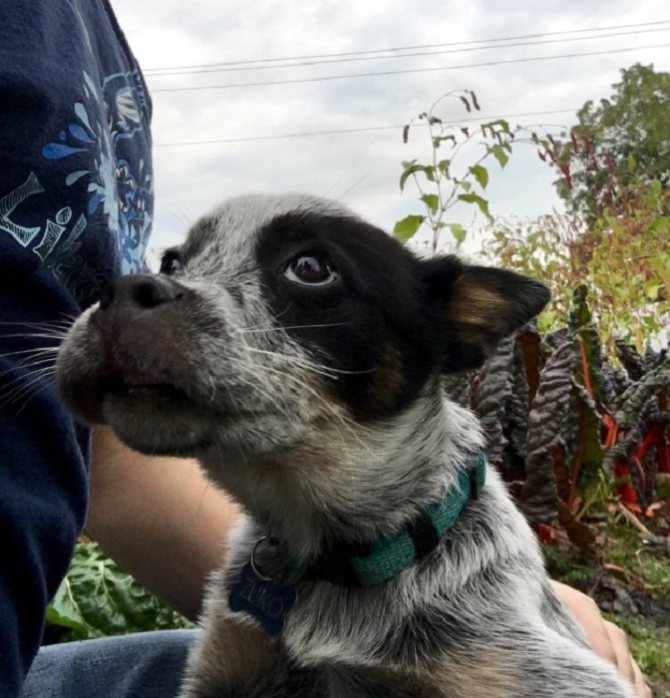

Here I am so handsome.
Stings of bees, wasps or hornets during pregnancy are just as dangerous as before and after it. Insects are dangerous for women who are allergic to bee venom, and in case of a bite, it is recommended to immediately consult a doctor.
If you are sure that there is no bee sting allergy, then the treatment of a pregnant woman does not differ from the treatment of a child and an adult. Although for a list of approved drugs, you should still go to a therapist or obstetrician-gynecologist.
Preparing for treatment
The course is conducted by an apitherapist, and not by a beekeeper, contrary to common misconception. For treatment, honey bees are needed during the season of active honey collection.
The actual treatment is started after a test for an allergic reaction - a bite in the lower back, after which the sting is left for a few seconds.
Waiting for a response from the body is at least an hour. Therapy is carried out with normal tolerance of the poison. In addition to an allergy test, laboratory tests of urine and blood are required. After receiving the results, the test is repeated.
How to relieve swelling after a bee sting


I just wanted to taste it.
And to raise the mood of 13 photos of funny dogs from an unusual angle.
It is recommended not to tear the bag of poison, crush or cut it. This leads to the formation of an even larger lesion area. Make a neat incision, remove the sting with a sharp object.
The site of the bite should be washed with a disinfectant solution. You can do this using:
- any alcoholic solution (for example, tincture of calendula),
- ethanol,
- solution of potassium permanganate or ammonia,
- clean water (in the absence of the specified funds).
Then, using tweezers or nails, carefully remove the sting that the bee left in the wound, but do not squeeze it out. This must be done very carefully: a bag with poison is attached to the sting shaft, pulling it out, it cannot be squeezed, since the poison will spread. If this does not remove the sting, you can use a needle.
If a bee has bitten, painful sensations can be eliminated:
- by attaching a clean napkin moistened with saline solution (it prevents the penetration of poison);
- rubbing a little aspirin powder into the affected area;
- neutralization of bee venom can be done with liquid soap;
- using antipruritic and pain relievers for external use (pramoxin, lidocaine, indrocortisone);
- in the absence of such funds, a piece of cucumber, a compress from dandelion juice, a leaf of plantain or rhubarb, chopped parsley root, a slice of onion can be applied to the wound.
To relieve swelling, you can make compresses with calendula tincture, aloe, onion juice, or apply ice, a piece of sugar. You also need to drink plenty of hot, sweet liquids.
If first aid is provided on time, then all signs of malaise should go away in a couple of days. Otherwise, if there are signs of poisoning (vomiting, fever or chills), you need to call an ambulance. You should not risk starting self-treatment, especially when it comes to a child.
In no case should you touch the bite site with dirty hands or “cover” it with raw black earth
How to provide first aid to a child with insect bites - bees, mosquitoes, midges, etc.?
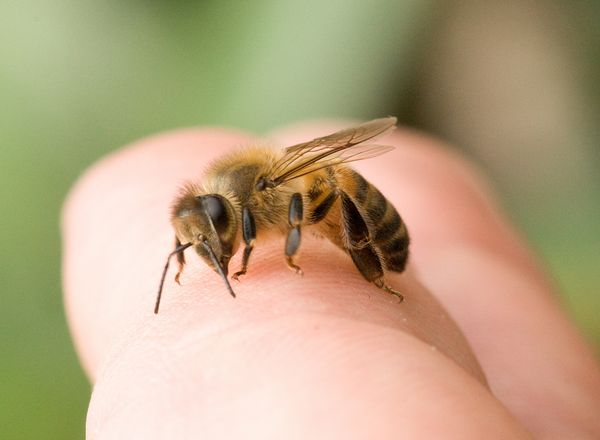

What nuances need to be taken into account - we will find out right now.
Any bee sting, even with a good reaction of the body, is accompanied by a slight swelling or a slight swelling.
Podmore-based recipes
With varicose veins
The best among bee products for varicose veins is considered to be suborrhea. The recipe for a miraculous tincture for the treatment of varicose veins is very simple:
- 100 g of podmore is steamed with hot water and infused for 15 minutes;
- The steam is lightly wrung out and placed in cheesecloth, previously folded in 3 layers.
After cooking, take cheesecloth with a darkening and put it on the inflamed area, covering it with cellophane. Then everything should be secured with an elastic bandage.
In addition to tincture, varicose veins are treated with bee stings, injections of drugs that are made on the basis of apitoxin. You can use ointments with poison, rubbing them into sore spots. Particular attention should be paid to bioactive supplements based on honey, which are now very popular.
With a viral infection
Take 1 tbsp. podmore, chop and fill with 1 glass of vodka. After that, the resulting mixture should be put to infuse for a month, while the first 7 days it must be shaken daily. After a week, shake it every 3 days. For the purpose of prevention, they drink as many drops that are equal to your age.
BPH
It is necessary to clean the podmore, then pour alcohol and leave for 3 weeks. At the end of the period, filter the mixture and drink before meals on a spoon with an interval of 12 hours. The treatment period is 1 month.
Who bit


This dog has not yet seen itself in the mirror.


It is unlikely that this poor animal is ready to be photographed now.
Before talking about providing assistance, you should find out if a person was stung by a bee or a wasp, since the number of manipulations necessary in such cases may vary. Wasps are more aggressive. This behavior of insects is explained by the ability to sting their prey repeatedly, without harming themselves in such cases. In addition, wasp venom acts much faster than bee venom.
Features of a bee sting
Bees rarely attack humans themselves, but there are a number of factors to which they react aggressively. For example, to strong odors (scent of perfume, cream, alcohol, onions, etc.). In addition, they can attack a person due to his sudden movements, which bees and wasps regard as a threat. In this case, stinging is their defensive reaction.
If you notice that an insect begins to circle around you, do not try to brush it off or crush it. Better to wait for the bee to fly away. Special attention should be paid to the fact that when crushed, the insect secretes special substances that lead the swarm into an aggressive state. Thus, a person runs the risk of being attacked by the entire bee family.
On the area stung by a wild wasp or bee, the victim develops redness, as in the photo below, a slight swelling, swelling and pain. However, he may have weakness, dizziness, or shortness of breath.It is worth noting that a bee or wasp sting can even cause shock, which is accompanied by intermittent breathing and the appearance of spots all over the body.
The hardest thing with a bee sting is for children and women during pregnancy. In such a situation, it is very problematic to carry out treatment, since most drugs are contraindicated for them.
However, bee venom is not only harmful, but also beneficial. In medicine, there is a separate area that deals with the treatment of various diseases using the poisonous substance of bees - apitherapy. Here's what a bee sting is for:
- metabolism improves;
- the activity of the inflammatory process decreases;
- the enzyme system is activated;
- helps to normalize blood pressure;
- cardiac activity is normalized;
- the work of the peripheral system improves.
The benefit also lies in improving microcirculation and increasing the content of red blood cells. But the benefits of bee venom are not limited to this either.
The sting of this insect can harm humans. Indeed, in the wound, unlike the wasp, it leaves its sting, which is a toxic poison. For this reason, different reactions occur. Sometimes, due to severe edema and a severe allergic reaction, a person dies.
The carpenter bee belongs to the Apidae family of solitary bees. At the moment, this insect is listed in the Red Book of the Russian Federation. If you are affected by a carpenter bee, painful swelling quickly develops in the affected area. The composition of its poison contains chemicals that have a depressing effect on the nervous system. Against this background, a nervous shock may occur, and death occurs with a bite in the throat.
The healing properties of apitoxin
Apitoxin is produced by the glands of worker bees. It is a thick, bitter liquid with a pungent odor. Has a strong analgesic effect (up to 50 times stronger than narcotic analgesics).
Affects primarily the cardiovascular, nervous, immune and endocrine systems.
The content of active components in bee venom depends on the age of the bee, the quality of the food environment and the degree of satiety. Worker bees are most capable of stinging, the peak of ability falls on 16-18 days of life.


Insects are capable of stinging only after they have eaten the pollen. When compared with snake venom, bee venom is softer and more active in its action. Its enzymatic activity is 25-30 times higher.
Features of bee venom:
- antiseptic, antibacterial effect (the strongest antiseptic - even in a 50-fold dilution it maintains sterility);
- analgesic, anticonvulsant effect;
- anti-edematous, vasodilating action;
- nootropic action;
- small doses tone the body, large doses promote relaxation;
- cardiostimulating, antiarrhythmic effect;
- hypotensive effect;
- improving the functioning of the spinal cord;
- blood thinning, increased hemoglobin concentration, anti-thrombotic effect;
- activation of motor activity;
- stimulation of the activity of the broncho-pulmonary system, expectorant effect;
- anti-erosive effect;
- hepatoprotective effect;
- activation of the adrenal glands and pituitary gland, increased metabolism;
- hypoglycemic effect.
In the human body, apitoxin causes physiological stress by altering the work of the endocrine glands. The vital functions of the body are activated, making it stronger and stronger.
Herbs and oils
These herbs have wound healing properties and help relieve the symptoms of bee stings:
- Aloe vera is well known for its softening and healing properties. Tear off an aloe leaf and squeeze the juice out of it onto the site of the bee sting.
- Calendula ointment has antiseptic properties and is used to treat minor wounds and relieve skin irritation. This ointment is applied to the bite site and covered with a bandage.
- Lavender essential oil has anti-inflammatory properties and can relieve puffiness. A few drops of lavender oil should be diluted with coconut or olive oil and applied to the bee sting area.
- Tea tree oil is a natural antiseptic and can relieve pain from bee stings. It is used in the same way as lavender oil.
- Witch hazel has worked well for insect bites. It relieves pain, inflammation and itching. Apply witch hazel to the affected area as needed.
Treatment of prostatitis with apitherapy
Treatment with bee stings for prostatitis is carried out when traditional medicine is powerless. Apitherapy can not only lead to a stable remission of the disease, it can completely get rid of the disease.
The most suitable time for the treatment of prostatitis is summer, during this period the bees are most active.
A bee sting must be placed not on the head of the penis, but on the foreskin. Actually, through it, apitoxin will be able to enter the body in a minimum amount of time, and then into the prostate.
Pain during the procedure most often disappears after 2-3 bites, this is justified by the anesthetic properties of the poison. Bee sting begins with 3-5 bites, and gradually reaches 35-40.
Today, there are other methods of bee therapy, which are based on applying bees to acupuncture points of the thighs, legs or other areas of the body.
After treatment, pain decreases, blood circulation in the prostate is activated, swelling and congestion in the prostate go away.

